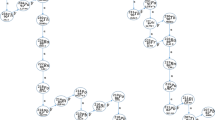Interest in 14C is increasing in connection with its accumulation in the Earth’s biosphere. Participating in exchange processes as a biogenic analog of stable carbon it penetrates into all organs and tissues of living organisms. The danger of its accumulation in the Earth’s biosphere is determined by a particular feature of the damaging action incorporated in living organisms. These particularities and as a result the danger for mankind and individual groups of the population living in regions containing sources of 14C are briefly examined in this article.
Similar content being viewed by others
References
Man: Biomedical Data, ICRP Publication 23, Meditsina, Moscow (1977).
V. P. Rublevskii, S. P. Golenetskyii, and G. S. Kirdin, Radioactive Carbon in the Biosphere, Atomizdat, Moscow (1979).
Sources, Effects and Risks of Ionizing Radiation, United Nations Scientific Committee on the Effects of Atomic Radiation, Rep. 1988, United Nations, NY (1988).
Ionizing Radiation: Sources and Biological Effects, UNSCEAR Report, New York (1982), Vol. 1.
V. P. Rublevskii, V. N. Yatsenko, and E. G. Chanyshev, The Role of Carbon-14 in Technogenic Irradiation of Man, IzdAT, Moscow (2004).
L. M. Gracheva and V. G. Korolev, Genetic Effects of the Decay of Radionuclides in Cells, Atomizdat, Moscow (1977).
N. A. Strelnikov, The Role of the Radiation and Transmutation Effect in the Biological Action of 14C and 32 P: Auth. Abstr. Candid. Dissert. Biol. Sci., TsNIRRI, Leningrad (1971).
L. Pauling, “Genetic and somatic effects of carbon-14,” Science, 128, No. 3333, 1183 (1958).
J. Totter, M. Zelle, and H. Hollister, “Hazard to man of carbon-14,” Science, 128, No. 3337, 1490 (1958).
M. D. Pomerantsev, “Genetic efficiency of various types of ionizing radiation,” Radiobiologiya, 4, No. 6, 810–817 (1964).
I. Ya. Vasilenko, V. A. Osipov, A. M. Lyaginskaya, et al., Kinetics of Metabolism and the Biological Effect of Radioactive Carbon ( 14 C), TsNIIatominform, Moscow (1988).
A. M. Germanskii, “Radiocarbon and natural mortality,” CBio.ru (2005), http://cbio.ru/page/43/id/1763/.
A. M. Germanskii, “Historical dynamics of the biological component of mortality in Sweden and Norway,” CBio.ru (2003), http://gealeksandr.narod.ru.
A. M. Germanskii, “Radioactive carbon natural background and natural mortality of people,” CBio.ru (2005), http://gealeksandr.narod.ru.
Author information
Authors and Affiliations
Additional information
Translated from Atomnaya Énergiya, Vol. 125, No. 5, pp. 301–306, November, 2018.
Rights and permissions
About this article
Cite this article
Rublevskii, V.P., Yatsenko, V.N. Features of Radiological and Biological Actions of 14C on Living Organisms and the Danger of its Accumulation in the Earth’s Biosphere. At Energy 125, 345–350 (2019). https://doi.org/10.1007/s10512-019-00492-7
Received:
Published:
Issue Date:
DOI: https://doi.org/10.1007/s10512-019-00492-7




